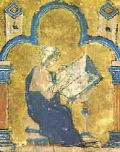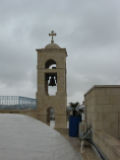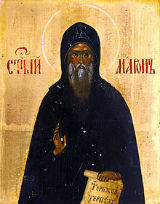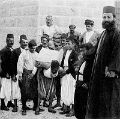| Главная » Файлы » "The Box of Antiquities" » Tower under Cedar |
"The Box of Antiquities" - Tower under Cedar
| 30.10.2012, 12:42 | |
William of Tyre (Wikipedia)
 Maronite fighters Maronite fighters Medieval chronicles narrate that "francs" (crusaders) moving along the coast of Phoenicia (present Lebanon) in the spring of 1099 found out that an army was going towards them. Crusaders were ready to take up arms but suddenly saw flags with crosses on them over the enemies. With smiles and salutatory exclamations the newcomers rushed towards the crusaders’ leaders. "Those were the Maronites who had become crusaders some four hundred years before, and were enthusiastic about offering guides and fighters,” wrote one of the chroniclers. What were they in the eyes of Europeans? It was "a race of people who lived in Phoenicia, from the edge of the Lebanese territory, to the city Jbeil (Byblos)… They were very strong people, used to bearing arms; they were of great help to our own Christians,” a famous Medieval historian William of Tyre wrote. It was the Maronites who showed the crusaders a short way to Jerusalem. "A good number of Maronite soldiers were found among the French who attacked and took the holy city on July 15, 1099,” another chronicler, Rene Ristelhueber wrote. The Maronites became strong allies of the Holy See in its war against Muslims, showing implicit fidelity to Vatican. In gratitude for their valuable services the Pope granted them his blessing and privileges and invoked the presence of the Maronite Patriarch to the Lateran ecumenical council. Henceforth the motto Gloria Libani data Est («The glory of Lebanon shall be given unto it»), twining around the tower standing in the shadow of a cedar under the Papal Tiara and his staff, has been adorning the coat of arms of the Maronite Patriarchy. During the rule of the crusaders Maronites protected holy places, accompanied pilgrims and legates. In return they got the best lands and prestigious posts at the court of the crusader kings. The story repeated, when in the 16th century the Holy See started returning to the Middle East. "Vatican transferred control of the holy places to Franciscans. However, they were unfamiliar with local realities, so the Pope asked our Patriarch to help them,” Paul N. Sayah, Maronite Archbishop of Haifa and the Holy Land, Exarch of Jerusalem, Jordan and the Palestinian Territory spoke proudly, when I met him in the Maronite Patriarchal Exarchate Foyer Mar Maroun in the Old City of Jerusalem. In search of truth Paul N. Sayah, Maronite Archbishop
of Haifa and the Holy Land (AUTHOR PHOTO)
 It’s not easy to find Foyer Mar Maroun, though it is near the central Jaffa Gate of the Old City. A narrow pass between the stone walls leads to Maronite Convent Street, where the Patriarchal Exarchate is located. The Exarch’s office is full of books on history and religion, folders with documents and photos. One of the pictures shows the Archbishop and the Pope. Grey-haired and swarthy, wearing a long black cassock and a big silver cross on his breast, Archbishop Paul Sayah looks confident and vigorous. His direct, attentive sight, dense eyebrows and heavy features of the characterful face show his austere nobility. It’s not easy to find Foyer Mar Maroun, though it is near the central Jaffa Gate of the Old City. A narrow pass between the stone walls leads to Maronite Convent Street, where the Patriarchal Exarchate is located. The Exarch’s office is full of books on history and religion, folders with documents and photos. One of the pictures shows the Archbishop and the Pope. Grey-haired and swarthy, wearing a long black cassock and a big silver cross on his breast, Archbishop Paul Sayah looks confident and vigorous. His direct, attentive sight, dense eyebrows and heavy features of the characterful face show his austere nobility.  The Maronites built this church at the end of the 19th century. However, they started settling in the city in the early centuries of the first millennium, before the arrival of the crusaders. The Maronites built this church at the end of the 19th century. However, they started settling in the city in the early centuries of the first millennium, before the arrival of the crusaders. "After Schism (in 1054) the Maronite Church was the only one in the East that remained the part of the Holy See,” said Sayah. What was before that? There is no clear answer to the question. St. Maron is known to be the founder of the Maronite Church. He led an ascetic life in the mountains of Syria near Antioch in the 4th century AD. The story goes that he founded many monasteries, cured the sick and helped the poor. He had many followers. It is known that he died in 410. The ascetic movement he had founded became later the Maronite Church. Paul Sayah quotes Theodoret, Bishop of Cyr, who wrote that St. Maron "lived in the ruins of an ancient pagan temple, transforming it into a place of prayer”. His body was taken to the south, to Lebanon. A monastery was erected over his burial place. After The Council of Chalcedon the followers of Saint Maron were accused of Monophysite heresy. Byzantium sent its armies against "dissenters" and with fire and sword took over Antioch, destroyed monasteries and massacred 350 monks. According to other sources, the Maronites were Monophyletic. St. Maron (Wikipedia)
 The Maronites themselves deny having been "heretics". They consider themselves the victims of intrigues. Neither assertion can be proved now. Anyhow, in the 5th-6th centuries the Maronite Church became independent. They elected their own patriarch, created the charter and the liturgy. According to an historian Joseph Mahfouz (Short History Of The Maronite Churh), the consequences of Latinisation "were unfortunate because the Maronite liturgy lost much of its oriental flavor”. "In our time the Maronite liturgy has kept Syriac as the liturgical language, but a great many of the texts used are in Arabic,” he wrote. Now, as 1500 years ago, the Maronite clergy (but not monks) has the right to marry. In the rest, despite some originality, Maronites completely adhere to Catholic canons. The Maronites themselves deny having been "heretics". They consider themselves the victims of intrigues. Neither assertion can be proved now. Anyhow, in the 5th-6th centuries the Maronite Church became independent. They elected their own patriarch, created the charter and the liturgy. According to an historian Joseph Mahfouz (Short History Of The Maronite Churh), the consequences of Latinisation "were unfortunate because the Maronite liturgy lost much of its oriental flavor”. "In our time the Maronite liturgy has kept Syriac as the liturgical language, but a great many of the texts used are in Arabic,” he wrote. Now, as 1500 years ago, the Maronite clergy (but not monks) has the right to marry. In the rest, despite some originality, Maronites completely adhere to Catholic canons. "Since the 8th century the Patriarch has been the spiritual and national leader of the Maronites, responsible for the real situation in the community. It was Patriarch Elias Howaiek who carried on negotiations in Paris on creation of the Lebanese state following the collapse of the Ottoman Empire. He was responsible for the political safety of both: religious community and Lebanon. The Patriarch is democratically elected so he can make important political decisions," Paul Sayah explains. Under rule of crescent After the creation of the Caliphate in the 7th century a lot of Maronites escaped from the northwest Syria to the remote mountains of Lebanon. There they built fortresses and embattled monasteries to again and again beat off Arab attacks. At that time the territory of present Lebanon was populated by Maradates who had come from Persia. They were very tall and incredibly strong ("Mared" means "giant"). Turned into Christianity by the Maronite monks, they helped the Maronites to fight Arabs. Chronicles narrate about a young and extraordinary brave Maronite leader Sem’an (Simon) who defeated the Muslims. During the internal Arab wars he intruded far into the Syrian territory. Moawia, the well-known Arabian commander and Caliph, tried to isolate the Maronites. Muslims settled all over Lebanon. However, it didn’t help. The Maronites continued their attacks. "To end it all, the Caliph had to make a peace treaty with them, agreeing to pay them a large sum of money every year, and to treat them as the Islamic State treats all those who become Muslim: thus, the Maronites were no longer considered as second class citizens, nor as enemies but as citizens with full rights. Rejoicing in this favorable treatment the Maronites felt emancipated, and went to live in regions which hitherto had been mainly Muslim, such as Damascus and elsewhere…,” wrote Joseph Mahfouz. The prosperity period was not long. The defeat of crusaders caused sharp strengthening of Islam and severe persecutions. The Mamlouks, new governors of the Middle East, were afraid of the Maronites and aspired to weaken them in every possible way. The mass slaughter of monks in 1367 became the culmination of violence and persecutions. Though the Patriarch managed to escape and hide with a handful of confidants in Qadish valley, the losses of the Maronite clergy were irreplaceable. The period of relative calmness followed the Ottoman conquest in 1510. After signing the agreement between Sultan Suleiman and the French king Francis I in the 16 century Catholic missionaries returned to the Middle East. Relations that had been broken between the Maronites and the Christian world, renewed. Moreover, the strong Maronites defended the weak and dependent churches in the region. Nevertheless, as any great power, the Ottoman Empire followed the well-known «Divide and Rule» principle. The people of Lebanon suffered the results of this policy to the full extent. In 1860 Turks provoked a conflict between Druze and the Maronites, which had terrible consequences for the latter. 20 000 Maronites were killed by Turks and Druze; 560 churches, 50 monasteries and 360 villages were destroyed; ten thousands Christians fled Lebanon. The tragedy repeated during the First World War when about one third of the Maronites perished or were exiled. In havoc of civil war Maronites in Lebanon
(Wikipedia)
 The third exodus occurred during the civil war in Lebanon in the 70s of the last century. Paradoxically, the Maronites, who had paved the way for Lebanese independence, paid the highest price during the conflict in this country. The third exodus occurred during the civil war in Lebanon in the 70s of the last century. Paradoxically, the Maronites, who had paved the way for Lebanese independence, paid the highest price during the conflict in this country. The reason for the civil war in Lebanon was the violence of the PLO gangs, who had moved to Lebanon from Jordan after the unsuccessful attempt to overthrow the King Hussein’s regime. «The fighters for the liberation of Palestine» turned the life of the local population, especially Christians, in South Lebanon, into hell. The decisive response of Christian militia fighters "Kataib" («Phalange Party») led by Bashir Jumayyil came in April, 1975. From this moment the rise of Bashir Jumayyil began. He headed the «Phalange Party» and managed to successively resist a coalition of Palestinians, Druze, their Muslim supporters in Lebanon and Syrians. Jumayyil was elected president but was assassinated a week later. He was killed in an explosion—a bomb had been planted in his headquarters by a member of the Syrian Socialist Nationalist Party on September, 14th, 1982. After that dramatic event the internal conflicts in the Christian community arose and played into the hands of the Maronites’ enemies. The Maronites began to leave the country, and their flight was accompanied by slaughters and massacres. Today the Maronite community remains split, and one of the former irreconcilable enemies of Syria, General Michel Aun, became its ally as well as of Iran and "Hezbollah". «There were good times in our relations with Muslims but there also were heavy conflicts,” Paul Sayah said. " Today we continue to influence the fate of Lebanon. Our Patriarch was the first to call for withdrawal of the Syrian army from Lebanon. Many politicians and journalists discussed his statement». Israel: between Jews and Muslims There are about one million Maronites in Lebanon. According to Lebanese constitution, the president must be a Maronite. Relatively small Maronite communities live in Syria, Egypt, the USA, Brazil, Argentina, Canada, and Australia, on Cyprus and in other countries. About 11 000 Maronites live in Israel, mainly in Galilee. About one thousand live in Jerusalem. The Maronite Archdiocese See is in Haifa. According to Sayah, the Maronites, as well as other Christian communities, do not face any formal discrimination in Israel, but often feel uncomfortable. «Of course, we do not face any persecutions,” he explains. "But we are insignificant minority and it is not easy to find our niche in the society. Jews do not distinguish us from Muslim Arabs. For them we are Arabs. Muslims, on their part, consider us infidels and treat accordingly». The isolation is especially bitter because the Maronites are proud of their achievements. Not only in Lebanon, but in Israel too they are one of the most educated communities. Thirst for knowledge was always characteristic of them. The foundation the Maronite College in Rome at the end of the 16th century gave a strong push to education in their community. In the Middle East, wishing to emphasize one's knowledge, they say «as educated as a Maronite». The Maronites have preserved the spirit of modesty and love that was characteristic of early Christianity and aspire to renewal. Nowadays they are trying to revive the characteristic features of their Church. And there is something more that gives the Maronites reason for pride. Many of them are convinced that they are the descendants of ancient Phoenicians. One of the most ancient peoples of the Eastern Mediterranean, having carried their individuality throughout history, continue their way to the future … Gloria Libani data Est still remains the motto of the successors of proud Phoenicians. | |
| Просмотров: 713 | Загрузок: 0 | Рейтинг: 5.0/1 | |
| Всего комментариев: 0 | |
